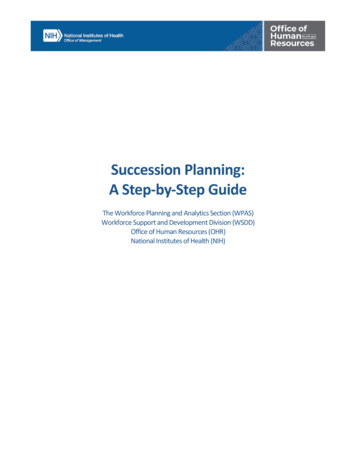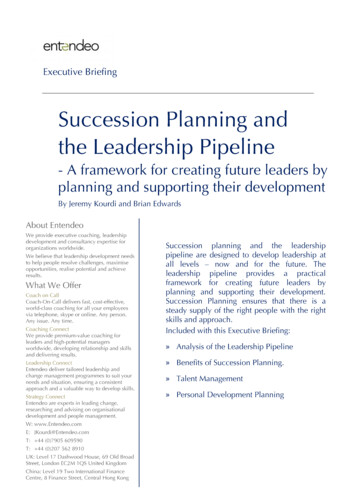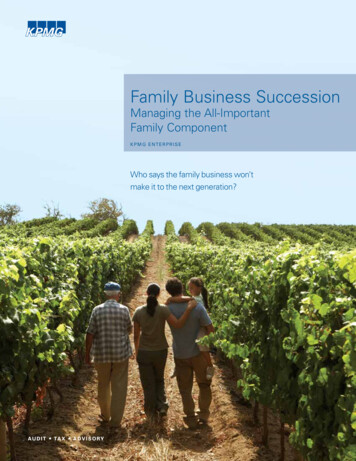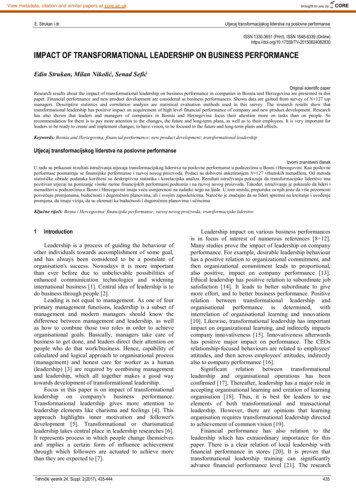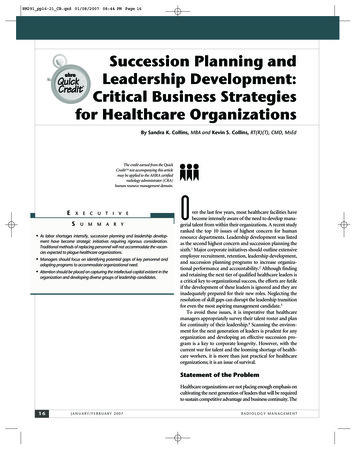
Transcription
RM291 pp16-21 CB.qxd 01/08/2007 08:44 PM Page 16Succession Planning andLeadership Development:Critical Business Strategiesfor Healthcare OrganizationsBy Sandra K. Collins, MBA and Kevin S. Collins, RT(R)(T), CMD, MsEdThe credit earned from the QuickCreditTM test accompanying this articlemay be applied to the AHRA certifiedradiology administrator (CRA)human resource management domain.EXSEUCUTIMMARVEY As labor shortages intensify, succession planning and leadership development have become strategic initiatives requiring rigorous consideration.Traditional methods of replacing personnel will not accommodate the vacancies expected to plague healthcare organizations. Managers should focus on identifying potential gaps of key personnel andadapting programs to accommodate organizational need. Attention should be placed on capturing the intellectual capital existent in theorganization and developing diverse groups of leadership candidates.Over the last few years, most healthcare facilities havebecome intensely aware of the need to develop managerial talent from within their organizations. A recent studyranked the top 10 issues of highest concern for humanresource departments. Leadership development was listedas the second highest concern and succession planning thesixth.1 Major corporate initiatives should outline extensiveemployee recruitment, retention, leadership development,and succession planning programs to increase organizational performance and accountability.2 Although findingand retaining the next tier of qualified healthcare leaders isa critical key to organizational success, the efforts are futileif the development of these leaders is ignored and they areinadequately prepared for their new roles. Neglecting theresolution of skill gaps can disrupt the leadership transitionfor even the most aspiring management candidate.3To avoid these issues, it is imperative that healthcaremanagers appropriately survey their talent roster and planfor continuity of their leadership.4 Scanning the environment for the next generation of leaders is prudent for anyorganization and developing an effective succession program is a key to corporate longevity. However, with thecurrent war for talent and the looming shortage of healthcare workers, it is more than just practical for healthcareorganizations; it is an issue of survival.Statement of the ProblemHealthcare organizations are not placing enough emphasis oncultivating the next generation of leaders that will be requiredto sustain competitive advantage and business continuity. The16JANUARY/FEBRUARY 2007RADIOLOGY MANAGEMENT
RM291 pp16-21 CB.qxd 01/10/2007 03:24 PM Page 17healthcare environment has historically promoted employeesinto leadership roles without thoroughly evaluating the truecapabilities of these individuals. Possessing a technical skilloften times has been the basic reason for promotion. However,technical skill does not always translate into leadership ability.Many of these talented individuals drown in their new roleslargely due to the lack of leadership training.Conversely, many internally qualified employees are overlooked for promotional opportunities because top leveladministrators are often unaware of the encompassing organizational talent. Externally recruited leaders are often hiredto fill the management vacancies. This sometimes causesaspiring leadership candidates to become disgruntled andeventually leave the organization.Demands on the recruitment and retention of skilledhealthcare professionals are increasing and more emphasis isbeing placed on leadership development and successionplanning. As the war for talent continues to intensify, healthcare facilities are being forced to evaluate ways to scan theorganizational environment for the next generation of leaders and to develop succession planning programs that assurethe continuity of long term corporate success.5Organizational SignificanceSuccession planning and leadership development pertain tothe strategic development of healthcare organizations. Whenmaking long and short term goals, healthcare organizationsmust carefully calculate who will champion their initiatives.6Selecting the appropriate individuals for leadership positionsis paramount to organizational success. Erroneously placingthe wrong person in a leadership role can result in devastating problems which are subject to strong public scrutiny.7These problems can range from lack of employee morale tofinancial destruction.3The demand for qualified and skilled leaders far outweighs the supply. Other industries outside of healthcare willalso be intensifying their efforts to attract new leaders. Thiscreates a mobile workforce that can find multiple positions inmultiple industries. This mobile workforce makes it evenmore challenging to retain the talented individuals in healthcare leadership roles.8 However, despite the challenge, theeffort must be made in order for healthcare organizations tosucceed in this consumer driven market. By combiningsound succession planning procedures and effective leadership development activities, healthcare facilities can create along-term process that will provide them with boundlessleadership talent. This strategic initiative is necessary todiminish the ill effects of a shrinking workforce.3organizational performance.9 Among the first studies toemerge on the topic of succession planning were those conducted by Henri Fayol. This twentieth century managementguru attempted to alert corporate leaders to the importanceof assuring the stability of their workforce. His theories surrounding succession planning indicated that failure to prepare the workforce of tomorrow would lead to filling leadership vacancies improperly. The need to have a body presentin the vacant position has often times been a motivator forhiring unqualified individuals. Fayol advised companies toresist this urge and encouraged them to think beyond theirpresent workforce needs.10Regardless of Fayol’s efforts, succession planning has nothistorically been a priority for most organizations.11 The issueof building layers of qualified leadership candidates has notbeen given the focused attention or dedicated resourcesrequired to prepare organizations for long-term success.12 Traditionally, the replacement method was used to fill vacancies inleadership. This consisted of pre-selecting substitutes for keypositions. A brief training period may have been implementedto provide the future replacement with information pertainingto the job they might need to fill. Emphasis was placed only onreplacement as an answer to vacancies created by a tragedy,such as death or a decision to leave for another position.8Despite regulations against age discrimination, individualsthat were identified as potential candidates for promotionalSuccession Planning Versus theTraditional Replacement MethodSuccession planning is defined as: Any process that isdesigned to ensure a continued pool of qualified candidates, thereby providing provisions to continue effectiveRADIOLOGY MANAGEMENTJANUARY/FEBRUARY 200717
RM291 pp16-21 CB.qxd 01/08/2007 08:44 PM Page 18Succession Planning and Leadership Development: Critical Business Strategies for Healthcare OrganizationsSuccession planning is different from replacement planning because itfocuses on forecasting organizational needs. It is not based upon reactionsto an unforeseen event. It is based upon proactively securing the humanresources needed to ensure the continuity and prosperity of the organization. Talent is observed and cultivated from within the organization.opportunities were typically expected to be younger thanthose they would succeed. This eliminated many qualified andeager candidates.5 Interestingly, the replacement method hasnot been linked to leadership development. Many healthcareorganizations treat staffing contingencies and leadershipdevelopment as two totally separate and unique concerns. Inreality, the two are vitally interconnected.13The replacement method has been utilized for decadeswith a relative degree of success because:1. Organizations were more stable and there were fewerchanges in job responsibilities or titles.2. Technical changes were not as rapid and were more easily anticipated.3. There were more middle managers available for replacement training.4. The human resource department employed larger numbers of staff that were dedicated solely to personnel development.5. Typical career ladders were rigidly determined andemployees rarely tried to deviate from the normal promotional routes.8The typical replacement method has known some level oforganizational success. However, the healthcare environmentis rapidly changing and new alternatives to staffing contingencies and leadership development must be considered.8Developing authentic succession planning programs isincreasingly important. Although the traditional replacementmethod and succession planning procedures overlap, thereare some major differences between the two. In times ofunexpected situations, there is a true need to sustain organization control quickly. This need has been demonstrated byunfortunate and rare accidents like the 1996 plane crash thatkilled over thirty top level executives including United StatesSecretary of Commerce, Ron Brown. Incidents like thisrequire quick action. This type of loss creates a need forreplacement processes as an aspect of risk management.Succession planning is different from replacement planning because it focuses on forecasting organizational needs. Itis not based upon reactions to an unforeseen event. It is basedupon proactively securing the human resources needed toensure the continuity and prosperity of the organization. Talent is observed and cultivated from within the organization.Each individual is groomed for their future roles through calculated development activities. This is why succession planning has been compared to a relay race. In fact, some refer to18JANUARY/FEBRUARY 2007the process as relay planning. Each individual in the race isequally qualified and prepared to carry the baton to the finishline. Succession planning deals with passing on responsibilityrather than merely filling a vacancy.9The business environment in healthcare organizations ismore unstable today because of change in hierarchical frameworks and the increase in competitive forces. Healthcaremanagers must think more strategically in terms of theirtalent roster.8 An organizations’ ability to master the abundant labor challenges forthcoming may make the differencebetween overall organization success and failure.7 Some ofthe organizational changes that make the traditional replacement method obsolete for today’s organizations include:1. Skilled employees have many choices. Promotion doesnot necessarily mean upward mobility.2. Technology is changing faster than ever before.83. Downsizing has eliminated layers of middle managersthat would have been suitable candidates for leadershipmentoring.74. Decentralization of human resource functions hascreated a fragmented organization effort.5. Upper level executives are met by increased demands.This makes it difficult to dedicate the time and effortrequired to develop the next level of leaders.86. Executives have a multitude of choices when it comes tocareer opportunities and employee loyalty is relic of the past.97. Trends such as outsourcing, automation, and globalcompetition have increased the labor crisis in service sectors such as healthcare.15Cultivating LeadersLong term business success depends on competitively retainingintellectual capital across the organization; the foundation ofeffective succession planning programs.9 Even though studiesindicate leaders cultivated and promoted internally producesignificantly better organizational performance than their externally recruited counterparts, little emphasis has been placed onleadership grooming.16 Making this issue even more significantare the research projects that indicate companies which place aheavy emphasis on leadership development experience considerably higher financial returns than companies that do not.17Many executives continue to believe successful leadersmust be born with their skill. They repeatedly attempt torecruit company saviors from outside the organization.RADIOLOGY MANAGEMENT
RM291 pp16-21 CB.qxd 01/09/2007 06:24 PM Page 19These externally recruited leaders often do not understandthe organizational culture and many times fail in their executive roles.18 Often times the recruit fails because they wereonly skilled in one particular area of healthcare. A transfer ofthis skill is not guaranteed in the new environment andexpertise in only one area may not be sufficient.13The quest for a corporate savior causes companies tooverlook talented individuals already within the organization. These talented individuals often have successfullymaneuvered through years of company politics and the organizational culture. With the appropriate training, cultivatingleaders from within an organization can provide the mosteffective leadership candidates.16 This training shouldencompass both an efficient succession plan and subsequentleadership development activities.13 Companies shouldattempt to use internal employees who are knowledgeable intheir particular field. This utilizes the leadership candidatesthat have practical application skills and provides a sense ofconnectivity with employees across the organization.18Potential Labor CrisisUnfortunately, healthcare organizations continue to underestimate their skilled workforce.19 This is a dangerous businessstrategy in lieu of the changes in the workforce. Decades of thepast have provided sufficient labor pools without fail and theworkforce of today is much more limited. The legacy of organizational cutbacks in the 1990s has diminished the traditional inhouse executive candidacy pools. The number of middle managers typically suitable for executive mentorship and promotionhas decreased dramatically. Organizational cutbacks are partially responsible for these decreases, but the aging population ispoised to create even larger labor shortages. The number ofretiring executives will drastically increase in the next few yearscausing a further labor crisis in upper management.9Challenges of ImplementationAlthough succession planning is vital for long term organizational success, most organizations do not know where tobegin in terms of implementing a program. Issues surrounding successful leadership development are abundant. Thereare problems associated with transitioning from the traditionalreplacement method to a new succession process. Furthermore, there is often controversy emerging whether leaders areborn with the required skills or if the skills can be attained.Many upper level administrators feel it is futile to attempt todevelop leaders because the necessary skills can not be taught.It is even more difficult for organizations to accurately identify the appropriate skills required to be a successful leader.Mastering these problems is extremely important whenimplementing an efficient succession planning and leadership development program. As the healthcare environmentcontinues to change, sensible healthcare organizations willlook beyond their current tier of leadership. A healthy supplyof healthcare leaders will be required.19 Successful organizations will create succession planning systems which will continuously provide qualified leadership candidates.5 Considering the replacement of key personnel only as a means toprepare for an unexpected death, for example, will simplynot be sufficient. There are other reasons for replacing executive leaders than just an untimely demise. Some executivesApproaches to Succession PlanningThere are a variety of approaches that can be utilized to successfully implement a succession planning program. Theapproach of choice depends on the strategic plan of theorganization. The top 6 approaches to succession planningare as follows:1. Top down approach—led by top level corporate executives.92. Market driven approach—based on immediate marketneeds and requirements.93. Career planning approach—individual employees areidentified for their skills and abilities.94. Futuring approach—externally scanning the environment for looming changes and matching internal talentwith subsequent labor need.95. Rifle approach—focused on solving specific problems fora particular time.96. Bottom-up approach—led by employees and allows formore than one direction of promotion.20RADIOLOGY MANAGEMENTJANUARY/FEBRUARY 200719
RM291 pp16-21 CB.qxd 01/08/2007 08:44 PM Page 20Succession Planning and Leadership Development: Critical Business Strategies for Healthcare OrganizationsConsidering the replacement of key personnel only as a means to prepare for an unexpected death, for example, will simply not be sufficient. There are other reasons for replacing executive leaders than justan untimely demise. Some executives leave because they are ready toretire, pursue different career opportunities, or are politicallydismissed. 21 Developing a full understanding of all these issues isparamount in effectively implementing a succession program.leave because they are ready to retire, pursue different careeropportunities, or are politically dismissed.21 Developing a fullunderstanding of all these issues is paramount in effectivelyimplementing a succession program.Executive support is vital in the succession planningprocess. Prudent executives will not view their positions aspermanent. They will recognize that the long term successof the company depends not only on their accomplishments, but also on those of the successor.11 Current leadersmust emphasize the need to develop future talent at all levels of the organization. The current executive should beinvolved in the development of the succession programso that it meets the organizational mission and vision.Economic demands are daunting as public expectations foreffective successors are amplified. Strategically developingthe next generation of leaders is no longer considered aboveand beyond normal business performance.9When developing a succession planning program, eachmember of the administrative team will need to focus on theskills required by future leaders. These skills must be determinedby considering the ever-changing business dynamics in healthcare.12 For example, it has been determined that new healthcaremanagers typically experience weaknesses in the areas of financeand leadership. Training in these particular areas should beimplemented and potential leadership candidates must beshown how these common weaknesses on the business sideaffect the patient-care side. It is important to make the correlation between the two sides because in a service oriented industrysuch as healthcare, many employees and managers are drivenprimarily by the patient-care side. The correlation between thebusiness side and the patient-care side is imperative if leadershipcandidates are going to be held accountable for both overallbusiness results and quality of care outcomes.22Furthermore, existing executives must painstakinglyapply sound deployment practices. Deployment is a processdedicated to assuring the right leaders are being placed in theright positions in order to effectively meet strategic planninginitiatives. This process ensures each potential leadershipcandidate makes the largest organizational impact possible.17To make the deployment process successful, the qualities ofsuccessful leaders must be fully understood and the organization must be capable of identifying these suitable characteristics.20JANUARY/FEBRUARY 2007It is extremely important that organizations realize the cultivation of leaders is the responsibility of each existing healthcare manager.7 Leadership candidates must be consideredfrom outside the existing senior ranks and recruited fromother levels within the organization. It is not suitable to onlyconsider those that are in lower to mid level managementroles as future upper level executives. The search for internaltalent must extend beyond the typical levels. Once talent hasbeen identified, it must be nurtured and developed basedupon organizational need.23Developing a sound succession planning program is essential to organizational success regardless of the size of the organization. Although many larger healthcare organizations mayhave some succession planning processes in place, small organizations are often guilty of overlooking the subject entirely. It iseasy to understand how this can happen. Building effective programs can be quite an intensive undertaking. The implementation of the rules, procedures, and techniques requires muchtime and effort. Time is something many executives simply donot have. The task of cultivating the next generation of leaders isoften an additional duty rather than a primary performanceindicator. When done appropriately, the succession planshould include key positions beyond those of upper management. Again, this requires much time and effort. The task ofdeveloping this type of program is typically given to the humanresource department. These individuals are not always trainedacademically for the issues surrounding extensive successionplanning and should not be forced to own the outcomes. Theseindividuals may be adequate at coordinating basic duties andensuring that development efforts are not merely tossed aside inlieu of more pressing issues, but a responsibility of this magnitude should not be placed solely on the human resourcesdepartment. The responsibility of assuring an adequate pool ofexecutive candidates should fall upon upper level management.Although initial efforts of developing a succession planningprogram target upper level administrators, attempts should bemade to phase into other levels within the organization.In fact, some experts agree bottom-up succession planning isfar more effective than top-down methods. The bottom-upmethod would not place top level administrators as the firstpriority. The focus would be on the identification of all keypositions, not just those in the upper administrative levels.9RADIOLOGY MANAGEMENT
RM291 pp16-21 CB.qxd 01/08/2007 08:44 PM Page 21Developing a sound succession planning program is essential to organizationalsuccess regardless of the size of the organization. Although many larger healthcare organizations may have some succession planning processes in place, smallorganizations are often guilty of overlooking the subject entirely.Since most succession planning programs are based on thetop-down method, there is little evidence to indicate thebottom-up method is truly more effective.ConclusionVirtually every healthcare organization will feel the need towiden their pool of qualified leadership candidates. Regardless of size or market dominance, most organizations areheaded into a talent war. The victor of the war for talent willemerge with flexible strategies designed to address the following areas:1. Organizational procedures that focus on future laborneeds.2. Sound retention policies intended to identify potentialleadership candidates earlier.3. Flexible work environments designed to maintain agingworkers with high potential.4. Increase organizational awareness of succession planningprograms and potential career opportunities.5. Integration of human resource departments with upperlevel administrators.Addressing these issues will provide solid groundwork fordeveloping practical succession planning and leadership development procedures. Attention should be placed on capturingthe intellectual capital existent in the organization and developing diverse groups of leadership candidates. Organizationscontinue to be driven to cultivate individuals with specializedskills and solid managerial competencies.9 Early identificationand development of these high potential employees is vital tobusiness success in all healthcare organizations.References8Byham WC. Grow your own leaders: how to identify, develop,and retain leadership talent. New Jersey: Prentice-Hall Inc;2002.9Rothwell WJ. Effective succession planning. New York:AMACOM; 2001.10Fayol H. Administration industrielle et generale. Paris: Societede l’Industrie Minerale; 1916.11Freeman KW. The ceo’s real legacy. Harvard Business Review.2004; 82(11):51–58.12Succession planning tool kit. Library Journal. 2004;129(17):39–40.13Fulmer RM, Conger JA. Developing leaders with 2020 vision.Financial Executive. 2004; July/August:38–42.14Scott A. Ethics and succession studied. Internal Auditor. 2004;61(4):17–19.15Stewart TA. Effective immediately. Harvard Business Review.2004; 82(6):10.16Passing the baton. Economist. 2004; 373(8397):57–58.17Donovan D, Bird A, Buchanan R, Rogers P, and Blenko M.Putting your leaders where it counts. European BusinessJournal. 2002; 14(3):144–149.18Tarley M. Leadership development for small organizations.Training and Development. 2002; 56(3):52–55.19Taylor RB. Leadership is a learned skill. Family PracticeManagement. 2003; 10(9):43–48.20Stevens P. Bottom up succession planning works better.Worklife Counselling. 2001:3–6.21Carnwath A. In my opinion. Management Today. 2004;October:12.22Pieper SK. Good to great in healthcare:how some organizations are elevating their performance. Healthcare Executives.2004; 19(3):21–26.23Sheppard G. Discovering new leaders. Training Magazine.2004; January:6.1American Society for Training and Development. Top tenthings that keep HR up at night. T&D. 2005; 59(6):17.2Soonhee K. Linking employee assessments to succession planning. Public Personnel Management. 2003; 32(4):533–547.3Conger JA, Fulmer RM. Developing your leadership pipeline.Harvard Business Review. 2003; 81(12):76–84.4Maurik JV. Opening both eyes on leadership training. Journalof European Industrial Training. 2001; 16(5):17–20.5Redeker JR. The legal overlay to succession planning. EmployeeRelations Law Journal. 2004; 30(2):23–29.6Aitchison C. Succession planning at the dixons group. Strategic HR Review. 2004; 3(5):24–27.7Buss D. When managing isn’t enough: nine ways to developthe leaders you need. Workforce. 2001; 80(12):44–48.RADIOLOGY MANAGEMENTSandra K. Collins, MBA, is an Assistant Professor at SouthernIllinois University Carbondale in the Health Care ManagementProgram. She has over 17 years of experience in themanagement of health care facilities. She can be reached atskcollin@siu.edu.Kevin S. Collins, RT(R)(T), CMD, MsEd, is an Assistant Professor atSouthern Illinois University Carbondale. He is the ProgramDirector of the Radiation Therapy and Medical DosimetryPrograms. He has 13 years experience in the field of RadiationOncology. He can be reached at kscollin@siu.edu.JANUARY/FEBRUARY 200721
AHRA Home-Study ResourcesSuccession Planning and LeadershipDevelopment: Critical BusinessStrategies for Healthcare OrganizationsHome-Study Test1.0 Category A credit Expiration date 2-28-2009Carefully read the following multiple choice questions. Mark your answerson the answer sheet found on page 24 and mail or fax the answer sheet to:The credit earned from the QuickCreditTM test accompanying this articlemay be applied to the AHRA certifiedradiology administrator (CRA)human resource management domain.AHRAAttn: Continuing Education Credit490-B Boston Post Road, Suite 101Sudbury, MA 01776Fax: (978) 443-8046QuestionsInstructions:Choose the answer that is most correct.1. In the top 10 issues of highest concerns for humanresource departments, where does leadership rank?a.b.c.d.FirstSecondFourthSixtha.b.c.d.2. Where did succession planning rank in the top 10issues of highest concerns for human 22Leadership developmentEmployee recruitment and retentionSuccession planningAll of the aboveJANUARY/FEBRUARYCorporate longevityProduct developmentEquipment acquisitionsNone of the above5. sicreasonforpromotioninthehealthcareenvironment.a. Trueb. False6. What problems might be associated with erroneouslyplacing the wrong person in a leadership role?3. Which of the following initiatives will help major corporations increase organizational performance andaccountability?a.b.c.d.4. In today’s healthcare environment, developing aneffective succession program is a key to:2007a.b.c.d.Financial destructionLack of employee moraleBoth a and bNone of the above7. Any process that is designed to ensure a continuedpool of qualified candidates is defined as:a.b.c.d.Employee satisfactionSuccession planningReplacement methodAll of the aboveR ADIOLOGYMANAGEMENT
8. Any process consisting of pre-selecting substitutes tofill vacancies in leadership positions is defined as:a.b.c.d.Replacement methodSuccession planningBoth a and bNone of the above9. Staffing contingencies and leadership development aretwo concerns that many healthcare organizations treatas separate and unique concerns.a. Trueb. False10. Factors that contributed to the success of the replacement method in previous decades include:a.b.c.d.More middle managers available for trainingOrganizations were more stableTechnical changes were not as rapidAll of the above11. Succession planning is different from replacementplanning because it focuses on:a.b.c.d.An unforeseen eventForecasting organizational needsFilling a vacancyNone of the above12. What has caused the business environment in healthcare organizations to be more unstable today?a.b.c.d.Changes in hierarchical frameworkIncreases in competitive forcesBoth a and bNone of the above13. What is the foundation of effective successionplanning?a.b.c.d.Externally recruited leadersCompetitively retaining intellectual capitalOutsourcingAll of the above14. Research projects indicate that companies whichplace a heavy emphasis on leadership developmentexperience:a.b.c.d.Higher financial returnChange in organizational cultureBoth a and bNone of the aboveR ADIOLOGYMANAGEMENT15. With the appropriate training, cultivating leadersfrom within an organizat
aspiring leadership candidates to become disgruntled and eventually leave the organization. Demands on the recruitment and retention of skilled healthcare professionals are increasing and more emphasis is being placed on leadership development and succession planni
